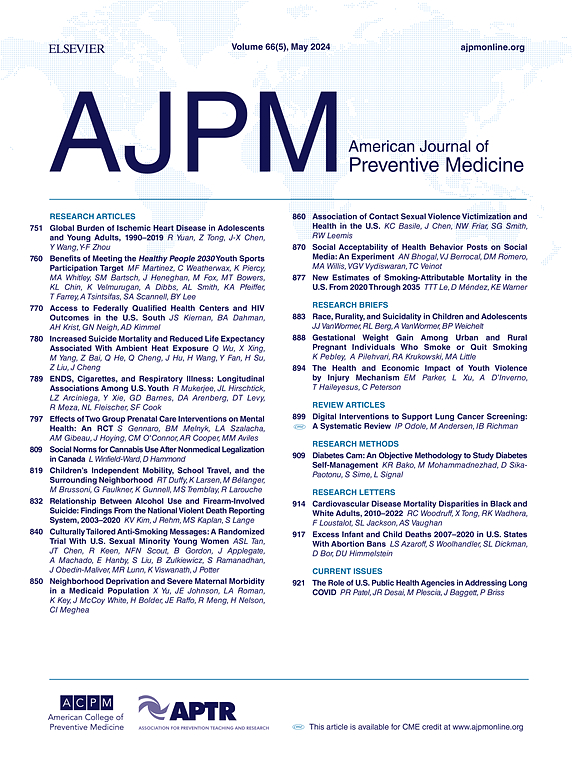2019-2024年美国电子烟销售趋势(以尼古丁毫克计)
IF 4.3
2区 医学
Q1 MEDICINE, GENERAL & INTERNAL
引用次数: 0
摘要
导言:电子烟的单位销售是使用一个包装中通常可用的项目数量来估计的,以标准化每个产品类型的单位销售。然而,最近的市场变化,如电子烟液体体积和尼古丁浓度的增加,对不考虑产品属性而根据项目数量评估销售的有效性提出了挑战。本研究测量了电子烟中尼古丁含量(mg)作为电子烟液体积(mL)和尼古丁浓度(mg/mL)的函数,并与按项目计数标准化的电子烟单位销量进行了比较。方法:分析Circana(2019年2月至2024年6月)美国电子烟零售数据。毫克尼古丁的销售趋势与标准化单位销售进行了比较。此外,按产品类型测量了销售加权平均电子烟液体积、尼古丁浓度和每毫克尼古丁的价格。使用Joinpoint回归评估趋势。分析于2024年进行。结果:从2020年2月到2024年6月,月销售的尼古丁毫克数增加了249.2%(结论:尼古丁是大多数电子烟中添加的成瘾性药物。以毫克的尼古丁含量来衡量电子烟的销量,可以更好地解释产品属性的快速变化,并为政策策略提供信息。本文章由计算机程序翻译,如有差异,请以英文原文为准。
Trends in U.S. E-cigarette Sales Measured in Milligrams of Nicotine, 2019–2024
Introduction
E-cigarette unit sales have been estimated using the number of items typically available in a package to standardize unit sales of each product type. However, recent market changes, such as increases in e-liquid volume and nicotine concentration, challenge the validity of assessing sales according to item count without accounting for product attributes. This study measured nicotine content (mg) in e-cigarettes sold as a function of e-liquid volume (mL) and nicotine concentration (mg/mL), compared with e-cigarette unit sales standardized by item count.
Methods
U.S. e-cigarette retail sales data from Circana (February 2019 to June 2024) were analyzed. Trends in mg nicotine sold were compared with standardized unit sales. Additionally, sales-weighted average e-liquid volume, nicotine concentration, and price per milligram of nicotine were measured by product type. Trends were assessed using Joinpoint regression. Analyses were conducted in 2024.
Results
From February 2020 to June 2024, monthly milligrams of nicotine content sold increased by 249.2% (p<0.001)—an increase 7.2 times greater than the 34.7% increase in standardized unit sales. Disposable e-cigarettes experienced the greatest increase in mg nicotine sold, which was largely driven by the rise in e-liquid volume. By June 2024, a disposable device contained 9.0 times more e-liquid than a prefilled cartridge. However, the price per milligram of nicotine in prefilled cartridges was 3.7 times greater than that of disposable devices.
Conclusions
Nicotine is an addictive drug added to most e-cigarettes. Measuring e-cigarette sales in milligrams of nicotine content sold could better account for rapid changes in product attributes and inform policy strategies.
求助全文
通过发布文献求助,成功后即可免费获取论文全文。
去求助
来源期刊

American Journal of Preventive Medicine
医学-公共卫生、环境卫生与职业卫生
CiteScore
8.60
自引率
1.80%
发文量
395
审稿时长
32 days
期刊介绍:
The American Journal of Preventive Medicine is the official journal of the American College of Preventive Medicine and the Association for Prevention Teaching and Research. It publishes articles in the areas of prevention research, teaching, practice and policy. Original research is published on interventions aimed at the prevention of chronic and acute disease and the promotion of individual and community health.
Of particular emphasis are papers that address the primary and secondary prevention of important clinical, behavioral and public health issues such as injury and violence, infectious disease, women''s health, smoking, sedentary behaviors and physical activity, nutrition, diabetes, obesity, and substance use disorders. Papers also address educational initiatives aimed at improving the ability of health professionals to provide effective clinical prevention and public health services. Papers on health services research pertinent to prevention and public health are also published. The journal also publishes official policy statements from the two co-sponsoring organizations, review articles, media reviews, and editorials. Finally, the journal periodically publishes supplements and special theme issues devoted to areas of current interest to the prevention community.
 求助内容:
求助内容: 应助结果提醒方式:
应助结果提醒方式:


